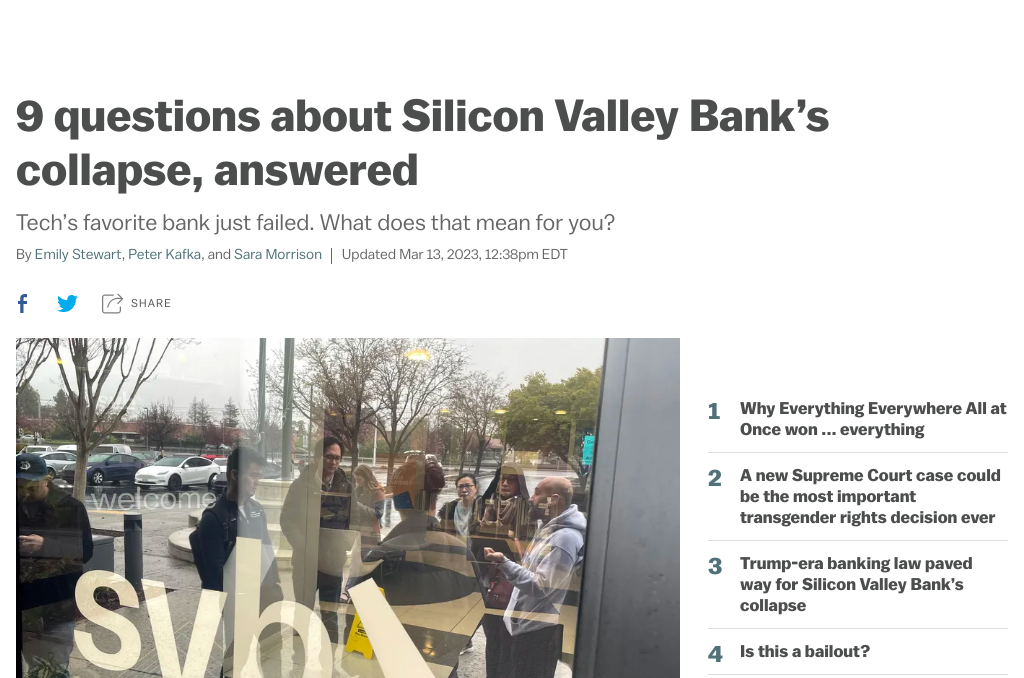Silicon Valley Bank (SVB) was a 40-year-old institution based in Santa Clara, Calif., that catered to nearly half of all U.S. tech startups backed by venture capital.[0] It was founded in 1983 with the intention of being the bank for the booming tech sector.[1] With its claim to bank for nearly half of all venture-backed startups as of 2021, it was tightly woven into the financial infrastructure of the tech industry, especially startups.[2] Despite being covered by the Federal Deposit Insurance Corporation, more than 90% of deposits exceeded the $250,000 limit for federal insurance on bank accounts, leaving many companies facing the potential of massive losses.[3]
On March 8th, the parent company of the bank, SVB Financial Group, declared it had sold $21 billion assets with a $1.8 billion loss and was going to raise $1.75 billion by selling shares to cover the shortfall.[4] The clients of the bank became fearful, causing the bank’s stock price to plunge. The next night, depositors attempted to withdraw $42 billion, which made the bank unable to pay its debts.[4] By Friday, the FDIC had seized SVB.[4] The Biden administration has taken an unprecedented step, ensuring that all customers of the defunct Silicon Valley Bank can access their funds in full.[3]
SVB was particularly flexible about lending tech startups money even though they didn’t have free cash flow or much in the way of assets, and was also often willing to work with founders who weren’t US citizens.[2] It offered loans, or “venture debt,” to startups that had secured venture capital but might not qualify for conventional bank financing, as well as lines of credit which allowed startups to cover dips in cash flow.[5]
The collapse of SVB came out of a panic and a bad bet on interest rates, and was a result of the bank’s concentration in its business. It was a highly concentrated deposit base and high exposure to one industry that opened it up to risk.[2] Startups and technology companies experienced considerable gains financially during the pandemic, some of which they deposited in Silicon Valley Bank.[6] The bank had plenty of money, so it followed its usual procedure: it kept a portion of it and invested the remainder – mostly in long-term Treasury bonds, which yielded good returns when interest rates were low.[6] Multiple times, they did rise.[4]
0. “Startups ‘on pins and needles’ until their funds clear from Silicon Valley Bank” NPR, 14 Mar. 2023, https://www.npr.org/2023/03/13/1163272334/silicon-valley-bank-startups-worries
1. “Takeaways from America’s second-largest bank failure” CNN, 11 Mar. 2023, https://www.cnn.com/2023/03/11/business/svb-collapse-roundup-takeaways/index.html
2. “What is Silicon Valley Bank? The bank’s collapse, explained.” Vox.com, 12 Mar. 2023, https://www.vox.com/technology/23634433/silicon-valley-bank-collapse-silvergate-first-republic-fdic
3. “Signature Bank’s collapse could deal a blow to cryptocurrency industry” The Washington Post, 13 Mar. 2023, https://www.washingtonpost.com/technology/2023/03/13/signature-bank-collapse-crypto/
4. “Silicon Valley Bank’s failure, the government’s depositor rescue, and venture capitalists’ incredible tantrum.” Slate, 13 Mar. 2023, https://slate.com/technology/2023/03/silicon-valley-bank-rescue-venture-capital-calacanis-sacks-ackman-tantrum.html
5. “Despite rescue, Seattle startups and banks face SVB blowback” The Seattle Times, 14 Mar. 2023, https://www.seattletimes.com/business/despite-rescue-seattle-startups-and-banks-face-svb-blowback/
6. “There’s a deeper story to Silicon Valley Bank’s failure. What can we learn from it?” The Guardian, 13 Mar. 2023, https://www.theguardian.com/commentisfree/2023/mar/13/svb-collapse-2008-financial-crisis
